Effective Communication and Teamwork in Pathology Lab Medicine Report
VerifiedAdded on 2020/04/01
|5
|1173
|48
Report
AI Summary
This report provides an overview of communication and teamwork within a pathology and lab medicine setting. It emphasizes the importance of careful handling of materials and the role of supervisors and assistants in maintaining order. The report details communication methods, including email and verbal interactions, highlighting the significance of politeness, etiquette, and clear instructions. It discusses how to take advice, give instructions, and offer professional opinions. The report also addresses potential difficulties in teamwork, such as staining procedures, and suggests solutions through expert consultation and clarification. It stresses the importance of note-taking, maintaining a quiet environment, and asking questions to ensure understanding and a positive working environment. The report concludes by reiterating the importance of efficient communication and seeking clarification when needed.
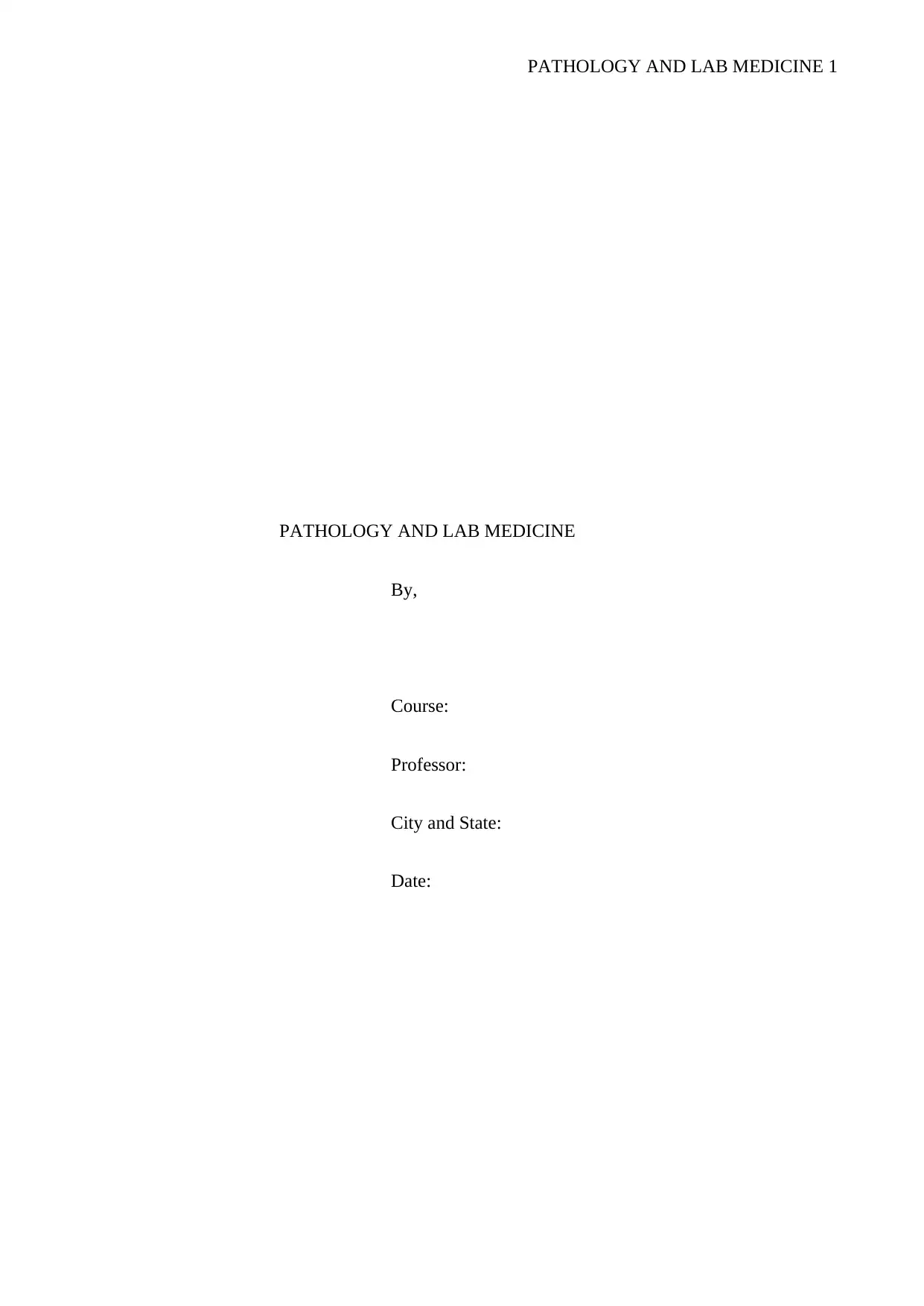
PATHOLOGY AND LAB MEDICINE 1
PATHOLOGY AND LAB MEDICINE
By,
Course:
Professor:
City and State:
Date:
PATHOLOGY AND LAB MEDICINE
By,
Course:
Professor:
City and State:
Date:
Paraphrase This Document
Need a fresh take? Get an instant paraphrase of this document with our AI Paraphraser
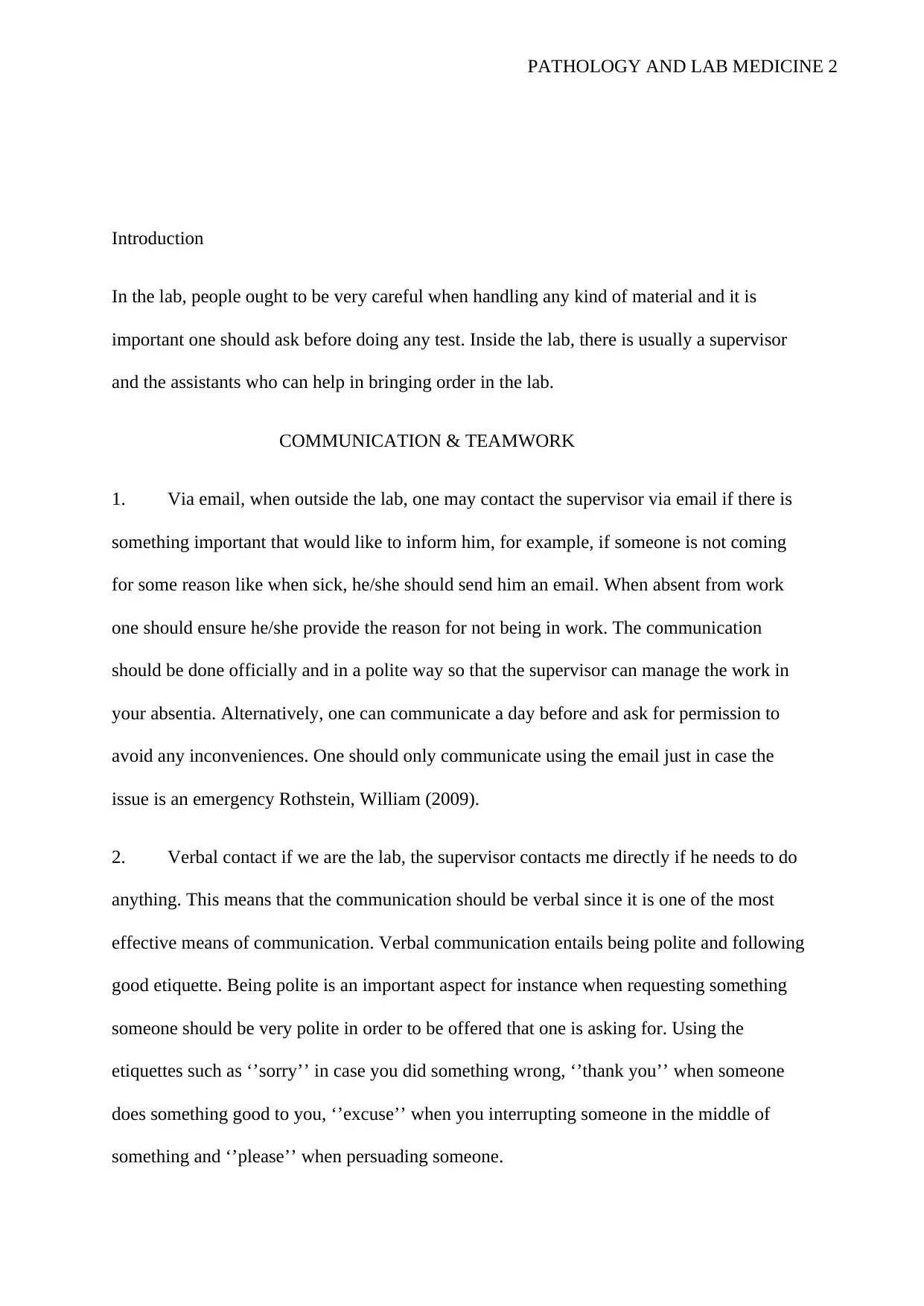
PATHOLOGY AND LAB MEDICINE 2
Introduction
In the lab, people ought to be very careful when handling any kind of material and it is
important one should ask before doing any test. Inside the lab, there is usually a supervisor
and the assistants who can help in bringing order in the lab.
COMMUNICATION & TEAMWORK
1. Via email, when outside the lab, one may contact the supervisor via email if there is
something important that would like to inform him, for example, if someone is not coming
for some reason like when sick, he/she should send him an email. When absent from work
one should ensure he/she provide the reason for not being in work. The communication
should be done officially and in a polite way so that the supervisor can manage the work in
your absentia. Alternatively, one can communicate a day before and ask for permission to
avoid any inconveniences. One should only communicate using the email just in case the
issue is an emergency Rothstein, William (2009).
2. Verbal contact if we are the lab, the supervisor contacts me directly if he needs to do
anything. This means that the communication should be verbal since it is one of the most
effective means of communication. Verbal communication entails being polite and following
good etiquette. Being polite is an important aspect for instance when requesting something
someone should be very polite in order to be offered that one is asking for. Using the
etiquettes such as ‘’sorry’’ in case you did something wrong, ‘’thank you’’ when someone
does something good to you, ‘’excuse’’ when you interrupting someone in the middle of
something and ‘’please’’ when persuading someone.
Introduction
In the lab, people ought to be very careful when handling any kind of material and it is
important one should ask before doing any test. Inside the lab, there is usually a supervisor
and the assistants who can help in bringing order in the lab.
COMMUNICATION & TEAMWORK
1. Via email, when outside the lab, one may contact the supervisor via email if there is
something important that would like to inform him, for example, if someone is not coming
for some reason like when sick, he/she should send him an email. When absent from work
one should ensure he/she provide the reason for not being in work. The communication
should be done officially and in a polite way so that the supervisor can manage the work in
your absentia. Alternatively, one can communicate a day before and ask for permission to
avoid any inconveniences. One should only communicate using the email just in case the
issue is an emergency Rothstein, William (2009).
2. Verbal contact if we are the lab, the supervisor contacts me directly if he needs to do
anything. This means that the communication should be verbal since it is one of the most
effective means of communication. Verbal communication entails being polite and following
good etiquette. Being polite is an important aspect for instance when requesting something
someone should be very polite in order to be offered that one is asking for. Using the
etiquettes such as ‘’sorry’’ in case you did something wrong, ‘’thank you’’ when someone
does something good to you, ‘’excuse’’ when you interrupting someone in the middle of
something and ‘’please’’ when persuading someone.
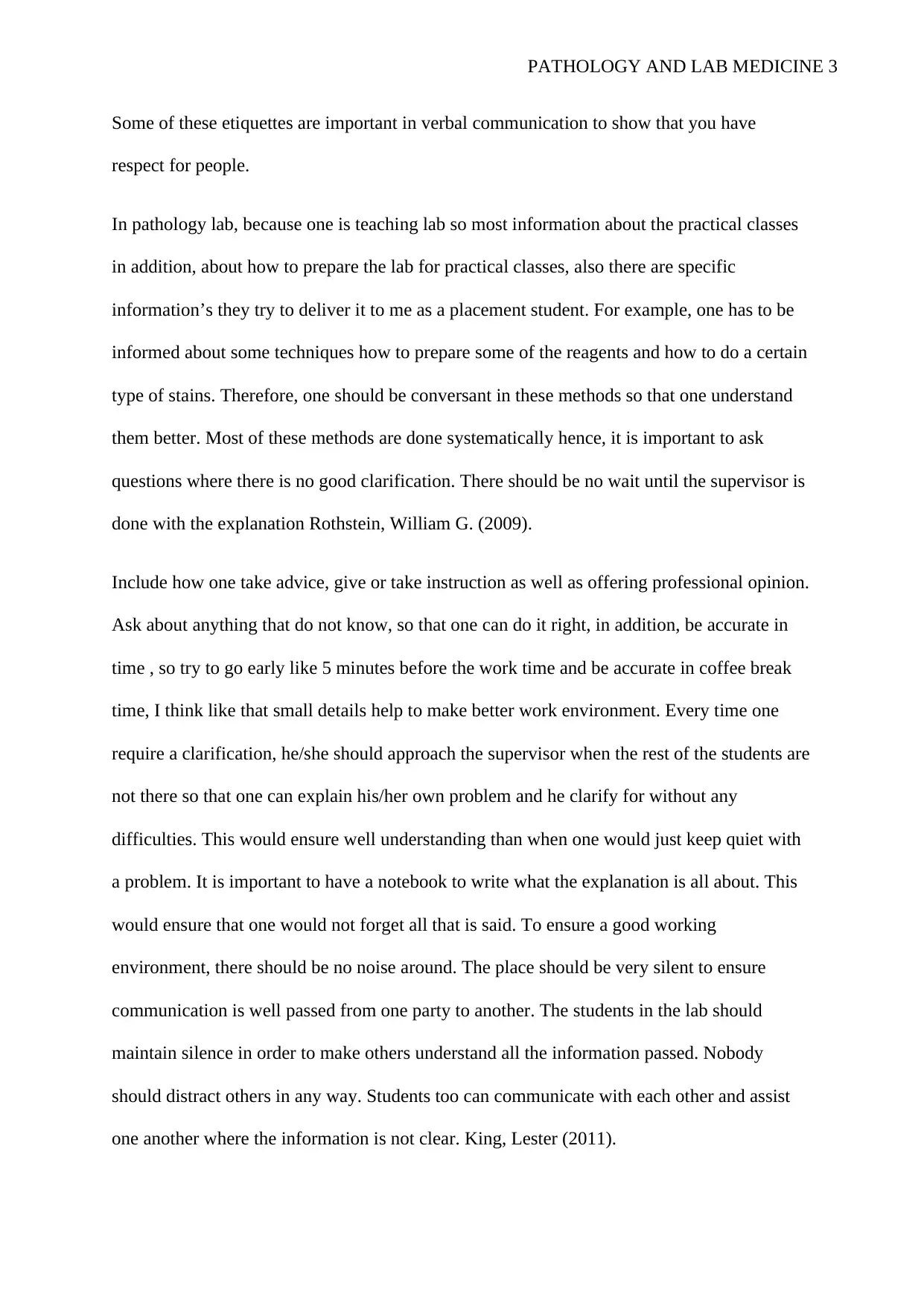
PATHOLOGY AND LAB MEDICINE 3
Some of these etiquettes are important in verbal communication to show that you have
respect for people.
In pathology lab, because one is teaching lab so most information about the practical classes
in addition, about how to prepare the lab for practical classes, also there are specific
information’s they try to deliver it to me as a placement student. For example, one has to be
informed about some techniques how to prepare some of the reagents and how to do a certain
type of stains. Therefore, one should be conversant in these methods so that one understand
them better. Most of these methods are done systematically hence, it is important to ask
questions where there is no good clarification. There should be no wait until the supervisor is
done with the explanation Rothstein, William G. (2009).
Include how one take advice, give or take instruction as well as offering professional opinion.
Ask about anything that do not know, so that one can do it right, in addition, be accurate in
time , so try to go early like 5 minutes before the work time and be accurate in coffee break
time, I think like that small details help to make better work environment. Every time one
require a clarification, he/she should approach the supervisor when the rest of the students are
not there so that one can explain his/her own problem and he clarify for without any
difficulties. This would ensure well understanding than when one would just keep quiet with
a problem. It is important to have a notebook to write what the explanation is all about. This
would ensure that one would not forget all that is said. To ensure a good working
environment, there should be no noise around. The place should be very silent to ensure
communication is well passed from one party to another. The students in the lab should
maintain silence in order to make others understand all the information passed. Nobody
should distract others in any way. Students too can communicate with each other and assist
one another where the information is not clear. King, Lester (2011).
Some of these etiquettes are important in verbal communication to show that you have
respect for people.
In pathology lab, because one is teaching lab so most information about the practical classes
in addition, about how to prepare the lab for practical classes, also there are specific
information’s they try to deliver it to me as a placement student. For example, one has to be
informed about some techniques how to prepare some of the reagents and how to do a certain
type of stains. Therefore, one should be conversant in these methods so that one understand
them better. Most of these methods are done systematically hence, it is important to ask
questions where there is no good clarification. There should be no wait until the supervisor is
done with the explanation Rothstein, William G. (2009).
Include how one take advice, give or take instruction as well as offering professional opinion.
Ask about anything that do not know, so that one can do it right, in addition, be accurate in
time , so try to go early like 5 minutes before the work time and be accurate in coffee break
time, I think like that small details help to make better work environment. Every time one
require a clarification, he/she should approach the supervisor when the rest of the students are
not there so that one can explain his/her own problem and he clarify for without any
difficulties. This would ensure well understanding than when one would just keep quiet with
a problem. It is important to have a notebook to write what the explanation is all about. This
would ensure that one would not forget all that is said. To ensure a good working
environment, there should be no noise around. The place should be very silent to ensure
communication is well passed from one party to another. The students in the lab should
maintain silence in order to make others understand all the information passed. Nobody
should distract others in any way. Students too can communicate with each other and assist
one another where the information is not clear. King, Lester (2011).
⊘ This is a preview!⊘
Do you want full access?
Subscribe today to unlock all pages.

Trusted by 1+ million students worldwide
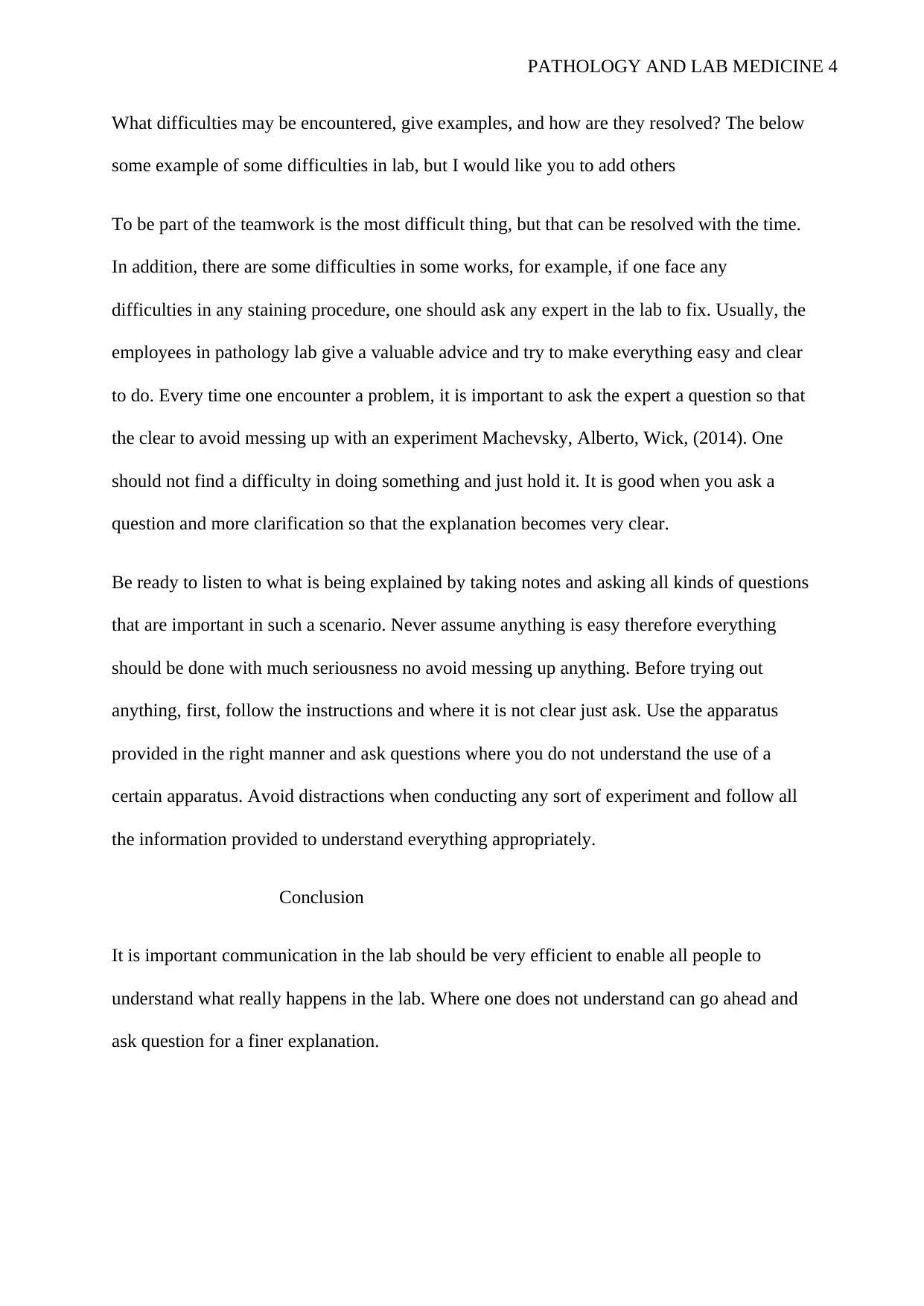
PATHOLOGY AND LAB MEDICINE 4
What difficulties may be encountered, give examples, and how are they resolved? The below
some example of some difficulties in lab, but I would like you to add others
To be part of the teamwork is the most difficult thing, but that can be resolved with the time.
In addition, there are some difficulties in some works, for example, if one face any
difficulties in any staining procedure, one should ask any expert in the lab to fix. Usually, the
employees in pathology lab give a valuable advice and try to make everything easy and clear
to do. Every time one encounter a problem, it is important to ask the expert a question so that
the clear to avoid messing up with an experiment Machevsky, Alberto, Wick, (2014). One
should not find a difficulty in doing something and just hold it. It is good when you ask a
question and more clarification so that the explanation becomes very clear.
Be ready to listen to what is being explained by taking notes and asking all kinds of questions
that are important in such a scenario. Never assume anything is easy therefore everything
should be done with much seriousness no avoid messing up anything. Before trying out
anything, first, follow the instructions and where it is not clear just ask. Use the apparatus
provided in the right manner and ask questions where you do not understand the use of a
certain apparatus. Avoid distractions when conducting any sort of experiment and follow all
the information provided to understand everything appropriately.
Conclusion
It is important communication in the lab should be very efficient to enable all people to
understand what really happens in the lab. Where one does not understand can go ahead and
ask question for a finer explanation.
What difficulties may be encountered, give examples, and how are they resolved? The below
some example of some difficulties in lab, but I would like you to add others
To be part of the teamwork is the most difficult thing, but that can be resolved with the time.
In addition, there are some difficulties in some works, for example, if one face any
difficulties in any staining procedure, one should ask any expert in the lab to fix. Usually, the
employees in pathology lab give a valuable advice and try to make everything easy and clear
to do. Every time one encounter a problem, it is important to ask the expert a question so that
the clear to avoid messing up with an experiment Machevsky, Alberto, Wick, (2014). One
should not find a difficulty in doing something and just hold it. It is good when you ask a
question and more clarification so that the explanation becomes very clear.
Be ready to listen to what is being explained by taking notes and asking all kinds of questions
that are important in such a scenario. Never assume anything is easy therefore everything
should be done with much seriousness no avoid messing up anything. Before trying out
anything, first, follow the instructions and where it is not clear just ask. Use the apparatus
provided in the right manner and ask questions where you do not understand the use of a
certain apparatus. Avoid distractions when conducting any sort of experiment and follow all
the information provided to understand everything appropriately.
Conclusion
It is important communication in the lab should be very efficient to enable all people to
understand what really happens in the lab. Where one does not understand can go ahead and
ask question for a finer explanation.
Paraphrase This Document
Need a fresh take? Get an instant paraphrase of this document with our AI Paraphraser
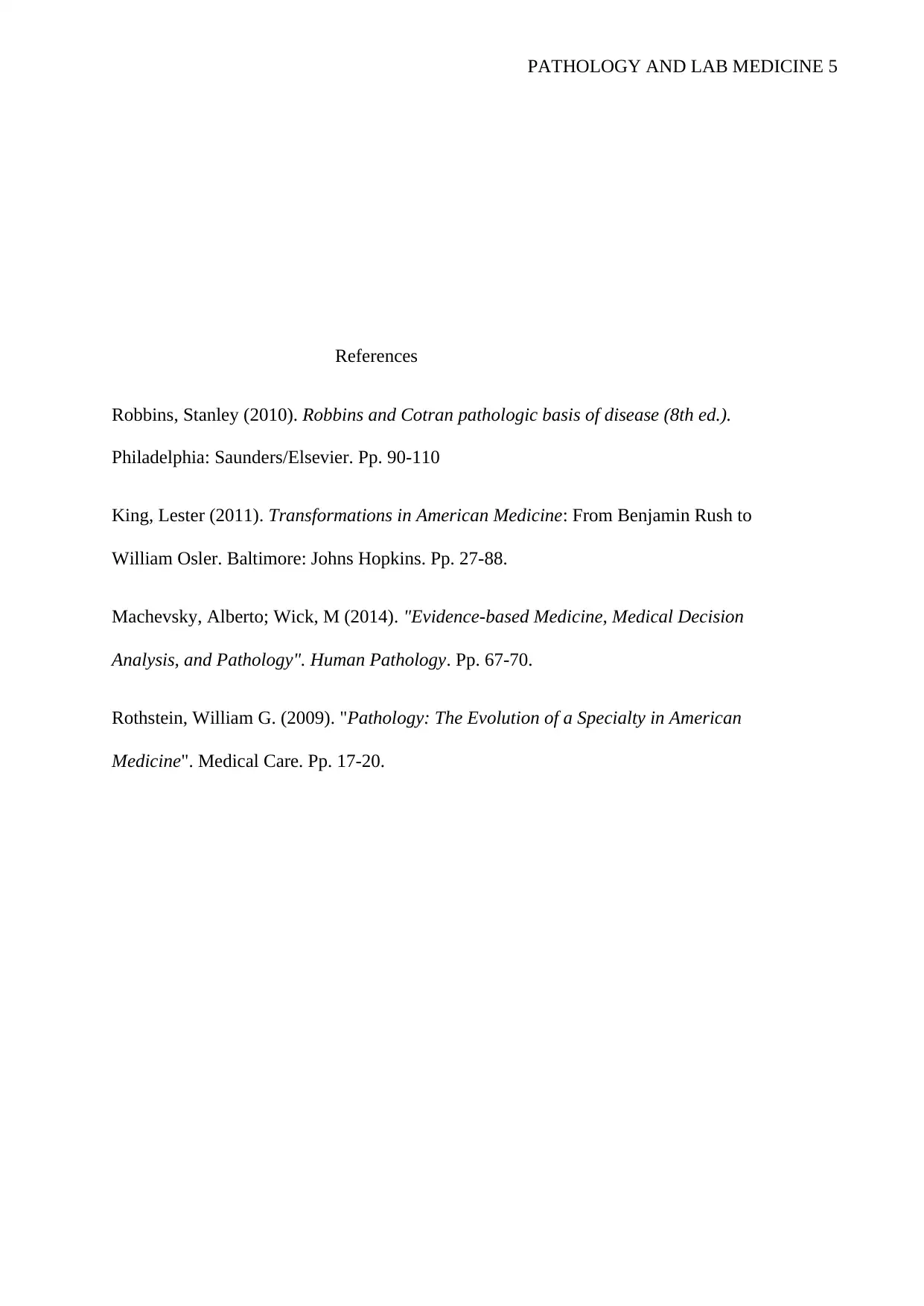
PATHOLOGY AND LAB MEDICINE 5
References
Robbins, Stanley (2010). Robbins and Cotran pathologic basis of disease (8th ed.).
Philadelphia: Saunders/Elsevier. Pp. 90-110
King, Lester (2011). Transformations in American Medicine: From Benjamin Rush to
William Osler. Baltimore: Johns Hopkins. Pp. 27-88.
Machevsky, Alberto; Wick, M (2014). "Evidence-based Medicine, Medical Decision
Analysis, and Pathology". Human Pathology. Pp. 67-70.
Rothstein, William G. (2009). "Pathology: The Evolution of a Specialty in American
Medicine". Medical Care. Pp. 17-20.
References
Robbins, Stanley (2010). Robbins and Cotran pathologic basis of disease (8th ed.).
Philadelphia: Saunders/Elsevier. Pp. 90-110
King, Lester (2011). Transformations in American Medicine: From Benjamin Rush to
William Osler. Baltimore: Johns Hopkins. Pp. 27-88.
Machevsky, Alberto; Wick, M (2014). "Evidence-based Medicine, Medical Decision
Analysis, and Pathology". Human Pathology. Pp. 67-70.
Rothstein, William G. (2009). "Pathology: The Evolution of a Specialty in American
Medicine". Medical Care. Pp. 17-20.
1 out of 5
Related Documents
Your All-in-One AI-Powered Toolkit for Academic Success.
+13062052269
info@desklib.com
Available 24*7 on WhatsApp / Email
![[object Object]](/_next/static/media/star-bottom.7253800d.svg)
Unlock your academic potential
Copyright © 2020–2025 A2Z Services. All Rights Reserved. Developed and managed by ZUCOL.





